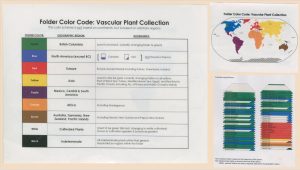
There are a variety of ways to organize and catalogue a collection. Many people use their collections as a reference for what a species ‘should’ look like and therefore organize the collection based on taxonomic hierarchy; Division, Class, Order, Family, Genus, Species.
Since the UBC Herbarium Collection has collections from all over the world, we also organize our collection based on geography. Understanding species distributions and having a variety of species from around the world allows comprehensive research of biodiversity around the globe.

Accessioning
While a collection number is a unique identifier for the collector, an accession number is a unique identifier for the specimen within the museum collection as a whole and makes each specimen easily searchable within the museum database. At UBC, each collection in the Herbarium is designated by a letter which is placed in front of the accession number in order to indicate which collection the specimen belongs to.
Our 5 Herbarium collections and their corresponding letters are:
- A: Algae
- V: Vascular
- B: Bryophytes
- L: Lichens
- F: Fungi
Accession numbers are sequential and can therefore also provide information on when a specimen was accessioned. For example, in the UBC vascular collection, the lowest accession numbers start at V1 and are associated with specimens accessioned in 1930s. Whereas our most recently accessioned specimens are being assigned numbers in the 200,000s.
